Even with a couple pockets of wealth, Tucson Unified College District is a mainly poor district that serves a the greater part-Latino inhabitants. White learners make up only about 20 percent of the district, and the broad the vast majority of pupils qualify for free and decreased-priced lunches. TUSD’s pupils slide driving their peers all around the point out in standardized tests, and students of shade slide even further more driving their white peers.
Romero and other Mexican American experiments founders hoped that by connecting history with present-day events and ethnic identification, the method would inspire Latino learners in certain to visualize a much better upcoming for by themselves, their communities and the state. The lessons, taught by a compact corps of academics distribute throughout the district, counted for needed graduation credits, while they weren’t necessary — college students have been cost-free to get common American history or literature classes instead. In 2010, just before the ban kicked in, the plan involved roughly 2,000 students for every calendar year and existed in 5 higher educational facilities, as perfectly as some middle and elementary faculties.
María Federico Brummer, who started training in the method in 2006, claims the lessons spoke to her pupils in a way that sparked mental curiosity and motivated them to picture a lot more for on their own. “As a middle school trainer, I could see it. I knew this was the way we should be teaching our students,” she suggests. “You saw these students were being emotion extra academically engaged, learners sensation for the initially time that they could be students in some way and that faculty was not a overseas put for them, but someplace wherever they could have a long term.”
Various surveys and impartial audits backed that up, obtaining that pupils enrolled in the plan saw enhanced scores in studying, crafting and even math. They also ended up significantly less probable to drop out, and more probably to truly feel engaged in college.
But critics, which include Paton, the Republican lawmaker who experienced picked up on Dolores Huerta’s reviews, described the application pointedly as a cult of individuality around Romero and other early leaders that had an “almost pseudo-spiritualistic” vibe. Academics who opposed the system reported harassment from Mexican American scientific tests teachers and students. Quite a few opponents of the system were being place on a blacklist and have lengthy suspected their opposition was the bring about.
“It was just truly unusual. There was a whole lot about self-assurance and link to my men and women — kind of liberation theology,” Paton states. “They ended up educating about Aztlán. … It was wholly wackadoodle.” (Aztlán is the name of the legendary homeland of the Aztec men and women, as very well as a term used by Chicano activists to refer to the region seized in the Mexican-American War.)
Doug MacEachern, a conservative editorial columnist for the Arizona Republic at the time, uncovered in the software a hardly ever-ending supply of commentary. “Until these ideologues obtained their claws in them, these young children in fact had a fantastic prospect at an schooling,” McEachern said in an interview. “I consider to continue to be absent from these terms, but you can not: They have been turning them into Marxist foot soldiers.”
Soon after a long time of attacking the system, Republican lawmakers finally place a invoice to ban lessons that instruct “racial resentment” and advocate “the overthrow of the government” on the governor’s desk in 2010. Brewer signed the legislation — as very well as Arizona’s hardline immigration laws, SB 1070 — the same 12 months.
When the hammer ultimately arrived down, Federico Brummer joined other academics in likely course-to-course to round up the guides they had utilised in the curriculum. Some learners cried, she says, as she boxed up copies of Elizabeth Martinez’s 500 Yrs of Chicano Heritage in Photographs, Luis Valdez’s Zoot Match and Rodolfo Acuña’s Occupied The usa. Learners held a 24-hour vigil.
Underneath threat from condition lawmakers and politicians in Phoenix to revoke tens of millions in condition funding for violating the ban, Tucson’s college board disbanded the system in 2011. That was when the battle reached its climactic instant, an intense confrontation not unlike the faculty board fights participating in out now — while it was pupils, not moms and dads, who led the protest.
On an April day that 12 months, a group of more than a hundred learners and supporters swarmed a school board conference in the district place of work. 9 of them stormed the dais and wrestled with stability prior to chaining on their own to the governing board members’ chairs. “Our training is less than attack,” they chanted. “What do we do? Battle again!”
The assembly was shut down, temporarily delaying the inescapable dissolution of the application. The affair made nationwide information, deepening the divide concerning the two sides and heightening the rigidity in the community.
Critics like MacEachern argue to this working day that the learners wouldn’t have protested without having orders from their lecturers. “Who bought them the chains and the padlocks?” he asked. But the lecturers were being happy of the students’ display, and they say they hadn’t prepared it — that the ban was an assault on the students as considerably as it was on the application.
“The most attractive component of it is that they were being able to preserve that a solution even from us,” Romero states. “The trustworthy real truth of this is, when I stood up and observed the pupils hurry in, they afraid the heck out of me too.”
All of this happened at a making an attempt time for Arizona’s Latinos. The immigration and instruction expenditures arrived on the heels voters’ overwhelmingly backing a proposal to bar undocumented learners from getting in-condition tuition to regional universities and group schools. It was the very same period when Maricopa County Sheriff Joe Arpaio was racially profiling Latinos in site visitors stops and conducting office raids on the lookout for undocumented immigrants. (Arpaio was afterwards convicted of prison contempt of court docket for defying an buy to halt racially profiling, a crime for which Trump pardoned him.)
As tense as individuals a long time were, in a way they have been also gratifying for leaders of the Mexican American studies system. The college students have been residing by way of the exact same struggles their icons experienced faced in Chicano legal rights motion many years earlier — the identical varieties of struggles they experienced read through about. They were fighting for superior training the exact way Dolores Huerta fought for far better doing the job conditions. They had been generating their own heritage.
“I observed our students manage and expand and make not just themselves very pleased, but their families and our community happy with the work they were performing to help save our application,” Federico Brummer suggests.
Indeed, the ban wasn’t the stop of Mexican American research in Tucson. In 2012, a federal court appointed a “special master” to oversee negotiations in the district’s a long time-aged desegregation scenario — an educational named Willis D. Hawley, who noticed the program’s benefit to Latino students. Hawley requested the district to reinstate Mexican American studies even though acquiring a way to comply with the 2010 condition law. So, the program’s academics and administrators began to rebuild. They ditched the identify Mexican American scientific tests in favor of “culturally responsive” lessons and curriculum. But the books the method employed ended up re-included, and most of the similar teachers stayed included.
Veterans of the Mexican American experiments software say it was never ever genuinely the exact after the state’s ban, having said that. Federico Brummer was demanded to undertake “retraining” to unlearn some of the strategies used in Mexican American reports, she claims. As they restarted the system, Arizona Office of Instruction officials, led by John Huppenthal — a main opponent of the application who became point out superintendent of community instruction, the state’s maximum instructional authority, just after the ban passed — sent monitors to the courses to preserve an eye on lecturers and even study their lesson ideas.
The TUSD’s culturally responsive curriculum application today is more substantial than Mexican American experiments ever was: It now involves extra than 200 teachers in history, literature and social scientific studies lessons for about 6,000 learners. It is in every high college and middle school in the district, with programs to expand into elementary schools. But devoid of the authentic committed main team of instructors, the courses just are not as excellent, says Federico Brummer, who is now director of the TUSD’s Mexican American Student Products and services. The spike in exam scores that teachers observed in the heyday of the plan has primarily light away, much too.
“We have an situation about amount versus excellent,” Federico Brummer suggests. “We have instructors getting ‘voluntold,’ ‘You’re going to teach this language arts class from a Mexican American viewpoint.’ And that’s fully distinct.”
What does Tucson’s embrace of ethnic experiments portend for the rest of the state as it debates whether or not schools need to — or even do — train significant race idea? The political context currently is various, as is the curriculum that’s up for discussion, but there are some classes from how the battle in Arizona performed out.











